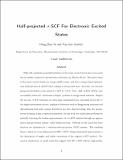Half-Projected σ Self-Consistent Field For Electronic Excited States
Author(s)
Ye, Hongzhou; Van Voorhis, Troy
Downloadhpsscf_new.pdf (701.8Kb)
Publisher Policy
Publisher Policy
Article is made available in accordance with the publisher's policy and may be subject to US copyright law. Please refer to the publisher's site for terms of use.
Terms of use
Metadata
Show full item recordAbstract
Fully self-consistent mean-field solutions of electronic excited states have been much less accessible compared to ground state solutions (e.g., Hartree–Fock). The main reason for this is that most excited states are energy saddle points, and hence energy-based optimization methods such as Δ-SCF often collapse to the ground state. Recently, our research group has developed a new method, σ-SCF [ J. Chem. Phys. 2017, 147, 214104], that successfully solves the “variational collapse” problem of energy-based methods. Despite the success, σ-SCF solutions are often spin-contaminated for open-shell states due to the single-determinant nature; unphysical behaviors such as disappearing solutions and discontinuous first-order energy derivatives are also observed along with the spontaneous breaking of spin or spatial symmetries. In this work, we tackle these problems by partially restoring the broken spin-symmetry of a σ-SCF solution through an approximate spin-projection scheme called half-projection. Orbitals of the projected wave function are optimized in a variation-after-projection (VAP) manner. The resulting theory, which we term half-projected (HP) σ-SCF, brings substantial improvement to the description of singlet and triplet excitations of the original σ-SCF method. Numerical simulations on small molecules suggest that HP σ-SCF delivers high-quality excited-state solutions that exist in a wide range of geometries with smooth potential energy surfaces. We also show that local excitations in HP σ-SCF can be size-intensive.
Date issued
2019-04Department
Massachusetts Institute of Technology. Department of ChemistryJournal
Journal of Chemical Theory and Computation
Publisher
American Chemical Society (ACS)
Citation
Ye, Hongzhou and Troy Van Voorhis. "Half-Projected σ Self-Consistent Field For Electronic Excited States." Journal of Chemical Theory and Computation 15, 5 (April 2019): 2954–2965 © 2019 American Chemical Society
Version: Author's final manuscript
ISSN
1549-9618
1549-9626